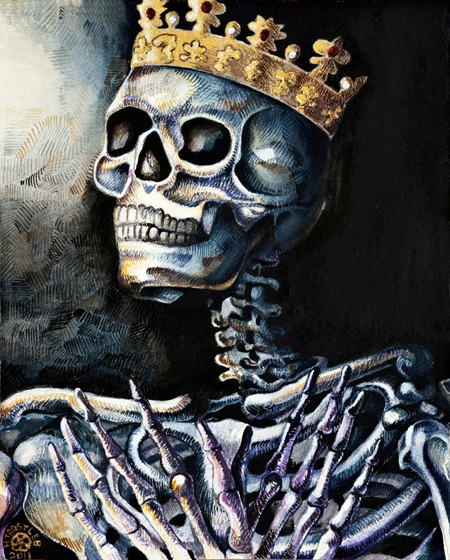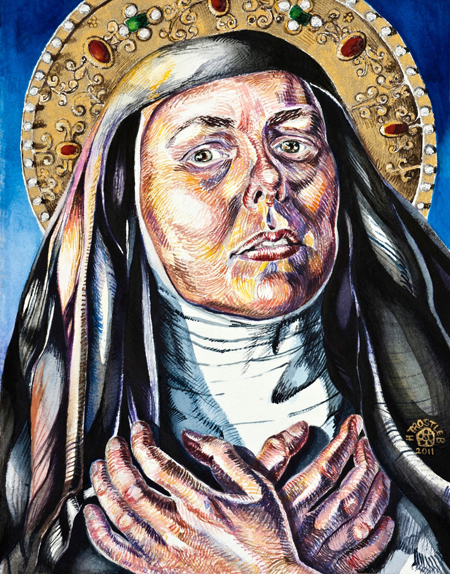Before the opening of Holly Trostle Brighman’s exhibition Holly Trostle Brigham: Dis/ Guise, I had the
opportunity to discuss the works in the show with her and delve into her
artistic thought process:
 |
| The artist in the Luther W. Brady Art Gallery. Photo: William Atkins |

 The piece, Hildegard’s Box,
is unlike the other works in the exhibit, it is a sculptural work that
incorporates Hildegard von Bingen’s songs. The work is a wooden box painted
with scenes in oil and features two portraits: Hildegard von Bingen and Dead
Hildegard. The door to the box is decorated with a sacred heart and remains
ajar, inviting viewers to peek inside. The interior of the box is covered in a
lush red fabric and contains two mysterious objects encased in jeweled gold
bags. I was eager to discover what the objects were, and during our discussion
I was intrigued to hear that it contains two organs – a heart and a tongue –
made of wax of course! Brigham expanded on this, explaining Hildegard’s heart
and tongue are rumored to be buried beneath the church of Eibingerstrasse in Rüdesheim, Germany.
The piece, Hildegard’s Box,
is unlike the other works in the exhibit, it is a sculptural work that
incorporates Hildegard von Bingen’s songs. The work is a wooden box painted
with scenes in oil and features two portraits: Hildegard von Bingen and Dead
Hildegard. The door to the box is decorated with a sacred heart and remains
ajar, inviting viewers to peek inside. The interior of the box is covered in a
lush red fabric and contains two mysterious objects encased in jeweled gold
bags. I was eager to discover what the objects were, and during our discussion
I was intrigued to hear that it contains two organs – a heart and a tongue –
made of wax of course! Brigham expanded on this, explaining Hildegard’s heart
and tongue are rumored to be buried beneath the church of Eibingerstrasse in Rüdesheim, Germany.
Two other works
in the exhibit are accompanied by relics, which Brigham integrated to provide a
more authentic atmosphere. A wedding
ring is hung beside the portrait, Henriette DeLille, to reinforce the
concept of nuns being married to God. The ring dates back to the early
nineteenth century, the time period that the Creole nun lived. Brigham
explained that it was common for convents to have a doll to represent baby
Jesus, which is why she portrays the figure representative of DeLille holding a
doll. The doll, which is depicted as an African-American highlights the nun’s
major accomplishment, founding the first African-American religious order –
Sisters of the Holy Family. She commented that she felt pity for nuns, because
they cared for the doll as if it were a real child, having no children of their
own. Santa Caterina’s Trinity, another religious portrait, is complemented
by a framed lock of hair. The lock of hair belongs to Brigham, which she
decided to use to demonstrate women having to cut their hair to show humility if
they wanted to become a nun.

Brigham places herself in the images
of female figures of the past in the hope of continuing their message and
keeping them alive. She is currently expanding her Seven Sisters II series with other creative images of
nuns. She hopes that when she enters the afterlife her works will
continue to spread not only her message, but also the messages of the women she
has depicted.

No comments:
Post a Comment